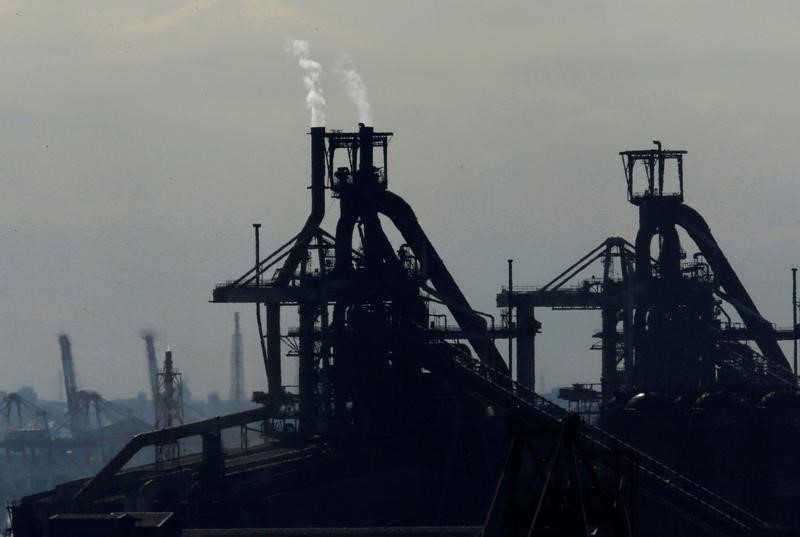* Rebar, iron ore prices down 23 pct from April peaks
* Steel inventories have risen after 8-week drop
* Some retail investors shifting back to stocks
By Manolo Serapio Jr and David Stanway
MANILA/BEIJING, May 11 (Reuters) - Only a month ago, Chinese commodities prices were skyrocketing, led by a stampede of speculative investors betting on early signs of recovery in the world's second-biggest economy.
Now, not only has the bubble been popped but a dive has left steel and iron futures 23 percent off their April peaks and in bear market territory. This in turn threatens to put the brakes on the restart of steel plants that became profitable as prices rose, as well as drive investors to other markets.
When prices shot up in April, Chinese commodities exchanges moved quickly to raise trading fees and push speculators to dial down trading positions, anxious to ensure there was no repeat of the boom and bust Chinese stocks suffered last year.
With steel prices falling sharply, the risk now is producers that reopened - dubbed "zombie" steel mills after being idled when prices slumped in recent years - will have to rethink.
"This month, some good mills are making money but their profits are dropping day by day. The half-dead steel mills that reopened will make big losses - they are uneconomic," said Xu Zhongbo, head of Beijing Metal Consulting which advises Chinese steel mills.
UNSOLD HOUSES
Weighing on steel prices, inventories held by Chinese traders rose 1.2 percent last week to 9.2 million tonnes, after falling for the past eight weeks, said Kevin Bai of CRU consultancy in Beijing.
"There have been a lot of reopened plants but demand has hardly improved," said Bai. "We think steel prices may still have some more downward pressure because of the supply response."
Rebar, a reinforced steel used in construction, fell to as low as 2,085 yuan ($320.40) a tonne SRBcv1 on the Shanghai Futures Exchange on Tuesday, before recovering some ground to close at 2,146 yuan on Wednesday, down 23 percent from its April peak.
On the Dalian Commodity Exchange, steelmaking raw material iron ore DCIOcv1 traded at 385 yuan a tonne on Wednesday, also 23 percent below its peak hit just two weeks ago.
There remains a significant inventory of unsold houses in some of the smaller, more provincial tier 3 and 4 Chinese cities that developers will focus first on selling before constructing new properties, said Standard & Poor's analyst May Zhong.
"Until we see meaningful destocking in the tier 3 and 4 cities, then we can't expect construction activity to pick up," said Zhong.
INVESTORS MOVE ON
The aggressive measures taken by commodity exchanges in Dalian, Shanghai and Zhengzhou to rein in speculation, from increasing trading fees and margins to widening daily movement limits, have helped encourage investors to look at other markets to put their money in.
"I am taking a break from commodities futures," said 42-year-old Ji Xiaoxu from China's Henan province, who has been investing in futures markets since 2009.
"I am doing some U.S. stocks at the moment as there is no leverage and is safer."
On Wednesday, the Zhengzhou Commodity Exchange said it would effectively raise trading fees for some institutional investors for rapeseed meal futures contracts from May 13 after a recent jump in prices CRSMcv1 . was April's surge in China's commodity futures trading that daily turnover in 18 contracts averaged $376 billion over the last two weeks, Morgan Stanley (NYSE:MS) said in a report last week.
But the short-term nature of the trading was also evident.
The average holding period in the past weeks for rebar and iron ore futures traded in China was only 2.0 and 2.4 hours, respectively, versus 25.8 hours for Brent crude LCOc1 on ICE Futures, Morgan Stanley said.
"In China, there is so much cash and people just follow the crowd," said Xu of Beijing Metal Consulting. ($1 = 6.5077 Chinese yuan)
<^^^^^^^^^^^^^^^^^^^^^^^^^^^^^^^^^^^^^^^^^^^^^^^^^^^^^^^^^^^ GRAPHIC: The bubble in China's commodities vs stocks
http://tmsnrt.rs/1W3ZW0J FACTBOX-China exchanges move to tame wild moves in commodities
GRAPHIC: China's commodities fall back to earth
http://tmsnrt.rs/1OmZVxe
^^^^^^^^^^^^^^^^^^^^^^^^^^^^^^^^^^^^^^^^^^^^^^^^^^^^^^^^^^^>
